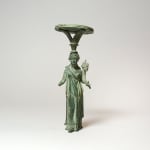Roman Bronze Lamp Stand Depicting the Goddess Fortuna, 100 CE - 300 CE
Bronze
height 24.1 cm
height 9 1/2 in
height 9 1/2 in
FZ.175
Further images
In antiquity, even everyday household objects could achieve an astounding beauty. Here Fortuna, whimsical goddess of success and plenty, gracefully balances herself atop a slender pillar to provide support for...
In antiquity, even everyday household objects could achieve an astounding beauty. Here Fortuna, whimsical goddess of success and plenty, gracefully balances herself atop a slender pillar to provide support for a lamp. As the lamp shed its light, so the goddess was to bestow her benevolent blessings on the household, bringing prosperity. The loveliness of this rare piece has remained intact through the ages, and so, we believe, has its lucky magic.
The Goddess Fortuna, identified with the Greek goddess Tyche, is often depicted carrying a (“horn of plenty”), and a ship’s rudder. Here, we see the cornucopia in her left arm, and her right hand may possibly have steadied a rudder while she stood.
In addition to her role as the goddess of fortune, however, Tyche was also the personification of a concept - - that both intrigued and inspired ancient Greek poets, philosophers, writers, and artists. This concept was variously interpreted over the years, and represented not only fortune, but also luck, success, or even chance.
Tyche is listed as one of the Oceanids (daughters of the Titans Tethys and Okeanos) in the of Hesiod. Indeed, paired with her sister Eudora, she and her sibling together represent a combination of Bounty and Luck according to the Oxford Classical Dictionary. This same source also indicates that Tyche appears again as a personification associated with Bounty in the Homeric Hymn to Demeter.
It is also worth noting that Tyche was a highly regarded goddess in many of the cities of ancient Greece. She was worshipped and honored as a sort of patron deity of luck or fortune in these cities. Works of art were created to celebrate the power and prestige of this important goddess, and two of the most famous examples of ancient images of Tyche were the statue of Agathe Tyche (Good Fortune) by Praxiteles and the Tyche of Antioch by Eutychides. The Hellenistic Tyche of Antioch, in fact, was so popular that it became the prototype and standard upon which other images of the goddess were based.
The Goddess Fortuna, identified with the Greek goddess Tyche, is often depicted carrying a (“horn of plenty”), and a ship’s rudder. Here, we see the cornucopia in her left arm, and her right hand may possibly have steadied a rudder while she stood.
In addition to her role as the goddess of fortune, however, Tyche was also the personification of a concept - - that both intrigued and inspired ancient Greek poets, philosophers, writers, and artists. This concept was variously interpreted over the years, and represented not only fortune, but also luck, success, or even chance.
Tyche is listed as one of the Oceanids (daughters of the Titans Tethys and Okeanos) in the of Hesiod. Indeed, paired with her sister Eudora, she and her sibling together represent a combination of Bounty and Luck according to the Oxford Classical Dictionary. This same source also indicates that Tyche appears again as a personification associated with Bounty in the Homeric Hymn to Demeter.
It is also worth noting that Tyche was a highly regarded goddess in many of the cities of ancient Greece. She was worshipped and honored as a sort of patron deity of luck or fortune in these cities. Works of art were created to celebrate the power and prestige of this important goddess, and two of the most famous examples of ancient images of Tyche were the statue of Agathe Tyche (Good Fortune) by Praxiteles and the Tyche of Antioch by Eutychides. The Hellenistic Tyche of Antioch, in fact, was so popular that it became the prototype and standard upon which other images of the goddess were based.









